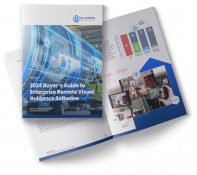Help Lightning Blog
Remote Assistance Software Benefits and Adoption Trends

This is an introduction to remote assistance software benefits and trends, sourced from the remote assistance software buyer’s guide written by Michael Blumberg.
TRENDS IMPACTING REMOTE VISUAL ASSISTANCE (RVA) ADOPTION
As mentioned previously, augmented reality has been available for some time. Only within the last few years has its use as a significant feature gained in popularity. AR has become an enabler for delivering remote visual assistance which in turn has become a preferred technology for delivering a touchless service experience to customers during the COVID-19 pandemic. Remote visual assistance enables companies to overcome the limitations and obstacles of social distancing and lockdown through the application of its video collaboration tools.
While COVID-19 accelerated the awareness and use cases for remote visual assistance software adoption, several other trends have influenced the demand for this technology:
- Faster Internet And Wireless Network Speed: These advancements, combined with improved network reliability and connectivity, now make it possible to inexpensively transmit large volumes of data, like voice, video, and images, on-demand and in real-time.
- Electronic Miniaturization: Electronic components have decreased in size while increasing in processing power and speed . This trend has led to a mass marketing of smart devices (i .e ., smartphones, smart glasses, etc .) that contain capabilities for sharing live videos, images, and annotations.
- Digital Transformation: Companies have been investing heavily in digital transformation to change how business gets done, resulting in new business models and cultures.
- Optimization Of The Service Supply Chain: For decades, manufacturers and service providers have been attempting to find ways to deliver a better service experience to customers while continuously finding ways to reduce costs, improve efficiency, and maximize productivity. The convergence of these trends has created an ideal environment for the deployment of remote visual assistance technology. It should come as no surprise that RVA represents the new standard for service delivery.
BENEFITS OF REMOTE ASSISTANCE SOFTWARE
In every one of these use cases, FSO utilize RVA software to achieve critical business objectives; these objectives include cost reduction, service excellence, and revenue growth. These are not new objectives for companies that provide field service and call center operations . Companies with these operations are continuously attempting to optimize or improve their performance in pursuit of these objectives. RVA technology enables companies to continually optimize service delivery performance.
As described above, RVA helps to lower costs by facilitating the ability to resolve calls remotely and avoid dispatching an FSE, and by making the call resolution process more efficient. Companies who utilize RVA software have observed the following improvements:
- 30% reduction in time to resolution
- 20% improvement in phone fix rate Companies can also achieve service excellence utilizing the technology because it allows them to meet and even exceed customer expectations as evidenced by the following performance metrics:
- 35% increase in first-time fix rates
- 30% increase in customer satisfaction RVA also supports business growth objectives.
Companies are finding that they can monetize their investment in RVA tools by offering remote support or RVA as a paid service. Learn more by downloading the remote assistance software buyer’s guide written by Michael Blumberg.












